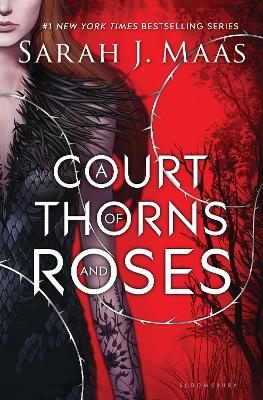
Kate (Blogging with Dragons)
Actual Rating : 3.5
I have a somewhat complicated history with this book. As a huge fan of the Throne of Glass series, also by Sarah J. Maas. I picked up this book for the first time over a year ago, expecting the main female character to be similar to Celaena of the former series. I was shocked by just how unlike the main character was to assassin Celaena. I could not believe “heroine” Feyre and her stupid decisions! I couldn’t understand how anyone could like this series and its main character, who often seemed determined to throw her life away. I wondered how someone could write something as wonderful as the Throne of Glass series, only to turn around and write this.
Flash forward a year later, to when I got deeper into the Maas fandom. I was surprised that everyone in the fandom utterly loved Rhysand, who I had thought was a mere despicable villain. Being the spoiler-loving wench that I am, I learned that Rhysand and Feyre were actually mates and was very surprised. I truly liked Tamlin in the first book, seeing as him as one of the only good things about it, and was super curious at what could have possibly happened in the second book that could change everything so drastically. With renewed curiosity and faith in Sarah J. Maas, I got the book from the library (again) and read it once more. After reading the book and the next one, I knew I’d buy the series in the future.
Anyways, this read through, I saw everything differently. Feyre was to be pitied for the choices she had to make and more importantly, the ones that were forced upon her. Having to support her disabled, unemployed father, and elder sisters, by hunting in the cold, dangerous woods that bordered Pyrthian, home of the feared fairies, was a grueling, lonely, and completely thankless task. I now saw that she had grown attached to Tamlin, High Lord of the Spring Court mostly because he was the only person who ever showed any amount of kindness towards her, however small. Upon this second reading, I realized that it was no wonder that she made impulsive and foolhardy decisions to save the only people that treated her like a real, decent human being and not just a tool that put food on the table.
But I still had to roll my eyes every time Feyre was told not to do something and then immediately rushed out to do the said thing and almost got herself killed—over and over. Don’t go hunting in the forest near the wall dividing the human wall and the Pyrthian lands? She did it and encountered a fairy in the form of a monstrous wolf. Don’t wander off the castle grounds of the Spring Court? Did it, and on the single worst, night of the year. Although it worked out because she met Rhysand. Don’t try to lure and trap an ancient and dangerous creature called a Suriel? She immediately did and almost died. Her stubbornness and dumb decision-making happened so often and with such similar results that it just made Feyre look suicidal and stupid, not powerful and capable, like the book so clearly wanted her to appear.
Though I initially thought Tamlin to be the beast in this unconventional Beauty and the Beast tale, complete with him showing up to take her away from her family and to take her to live in his castle in the fairy world, complete with a curse on him and his court for Feyre to break with her love. I realized that the true beast, or rather, fairy, to be pitied in this story was actually Rhysand, High Lord of the Night Court. And when Rhysand appeared before Feyre, I was suddenly shaken by how I had essentially dismissed him and never even viewed him as the attractive, sensual, and intelligent being he actually was:
“Everything about the stranger radiated sensual grace and ease….His short black hair gleamed like a raven’s feathers, offsetting his pale skin and blue eyes so deep they were violet, even in the firelight. They twinkled with amusement as he beheld me.”
Well, damn. I hadn’t fallen for a fictional character in a while, so I guessed my time was up and Rhysand had come to collect. I wondered how I hadn’t possibly recognized his value, his ability to maneuver the political minefield to which he had been subjected after evil and twisted Amarantha stole most of his powers and imprisoned him Under the Mountain in her court. I guess I was too busy being frustrated at Feyre and her actions. But I loved that Rhysand, firmly embraced what many called him “Amarantha’s whore,” played his part, and used it to save not only Feyre, but also his people. Feyre, too, realized, though reluctantly, during the course of her imprisonment in Amarantha’s court that devious and seemingly wicked Rhysand, and not her love Tamlin, “had effectively kept [her] from shattering completely.”
But ultimately, I figured out that the best way to enjoy this book was not to look at it as a retelling of Beauty and the Beast at all. Otherwise, the curse, which involved not much more than its victims wearing masks and its simplicity would bore you, the almost instantaneous and unfounded love between Feyre and Tamlin would disappoint you, and Feyre’s role as Belle would make you roll your eyes. Instead, one should look at the novel for what it was, the starting point of a series about fairies, their courts, and an even bigger approaching evil, which just so happens to have a few Beauty and the Beast undertones.
Regardless of this altered viewpoint, I liked this book much more the second time around. So when the book ended with, the restoration of the High Lords’ powers and Feyre’s resurrection as a High Fae at their bidding, I knew I needed more. I couldn’t get the sequel, A Court of Mist and Fury in my hands fast enough. I was also pleased to find that I liked the second book much better than the first, with Feyre being much more complex and developed. It no longer felt like Maas was forcing down my throat how supposedly bad-ass she was and instead Feyre just was more confident, strong, and empowered. What a relief. Plus, there was lots and lots of Rhysand. But more on that in a future review.
In the end, I was really glad that I gave this book and the series another chance. In fact, I realized that I loved the story and its characters possibly even more than those in the Throne of Glass series. With my faith in Sarah J. Maas, restored, I couldn’t wait to see where she took the characters next.




